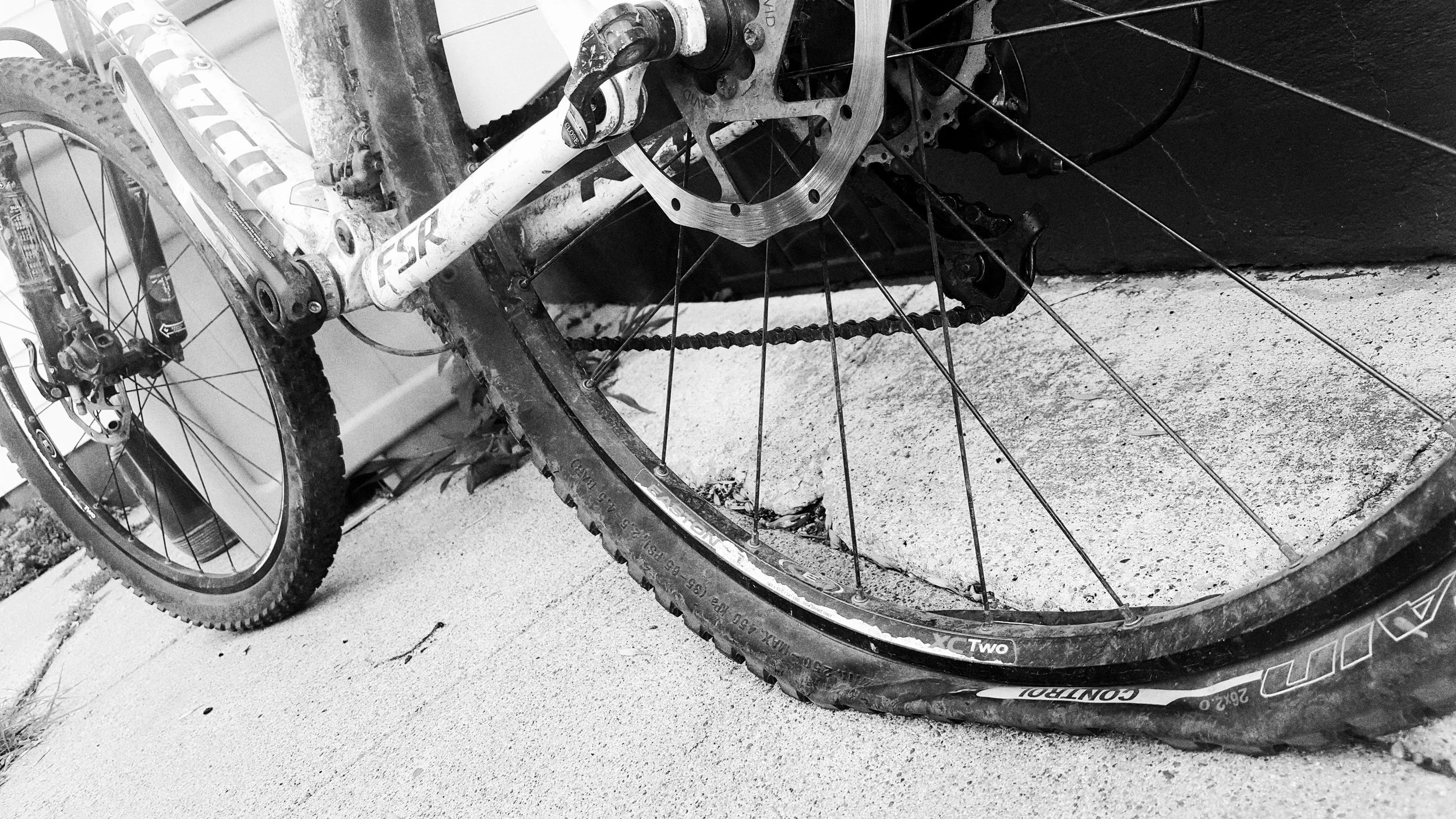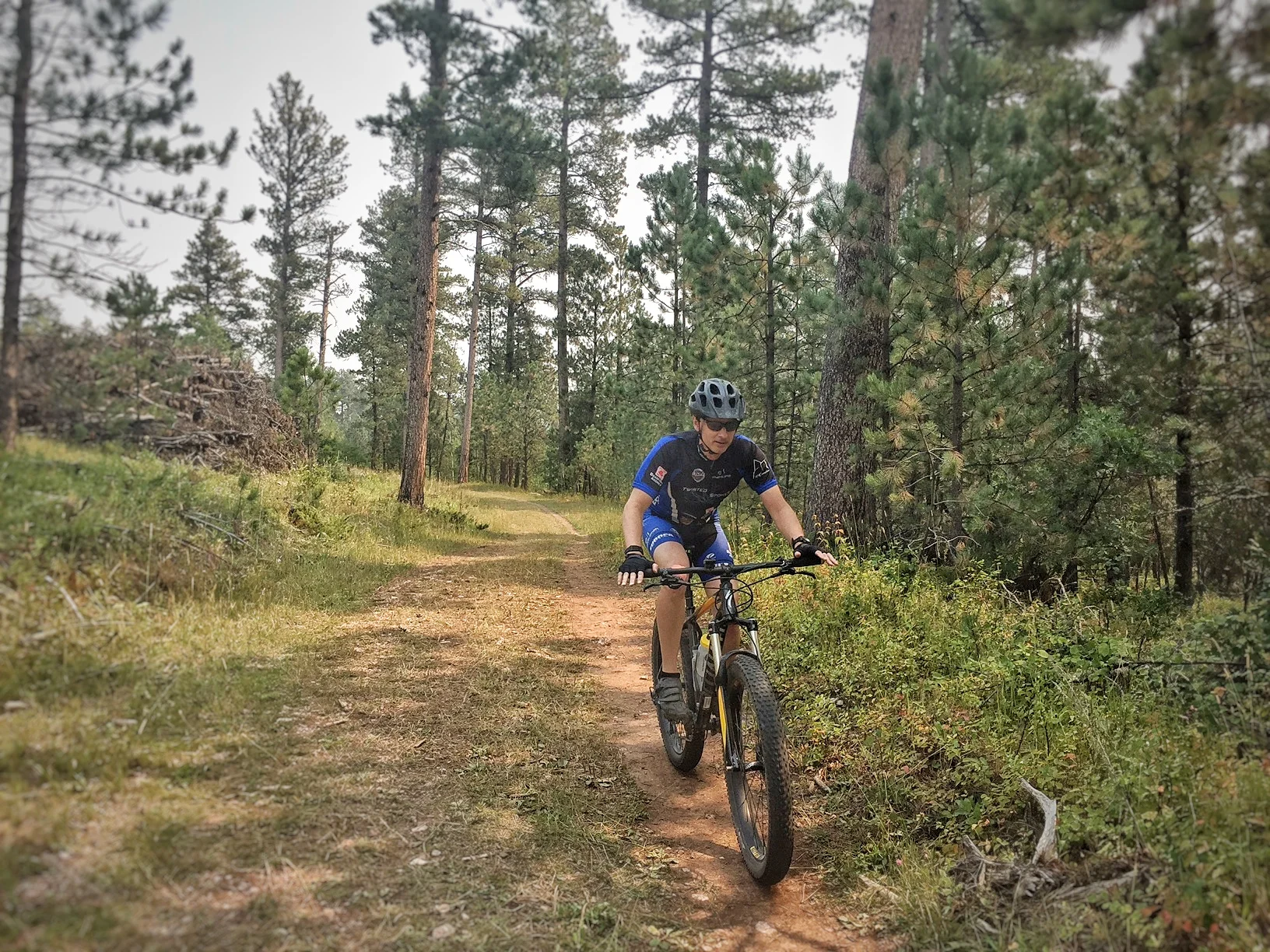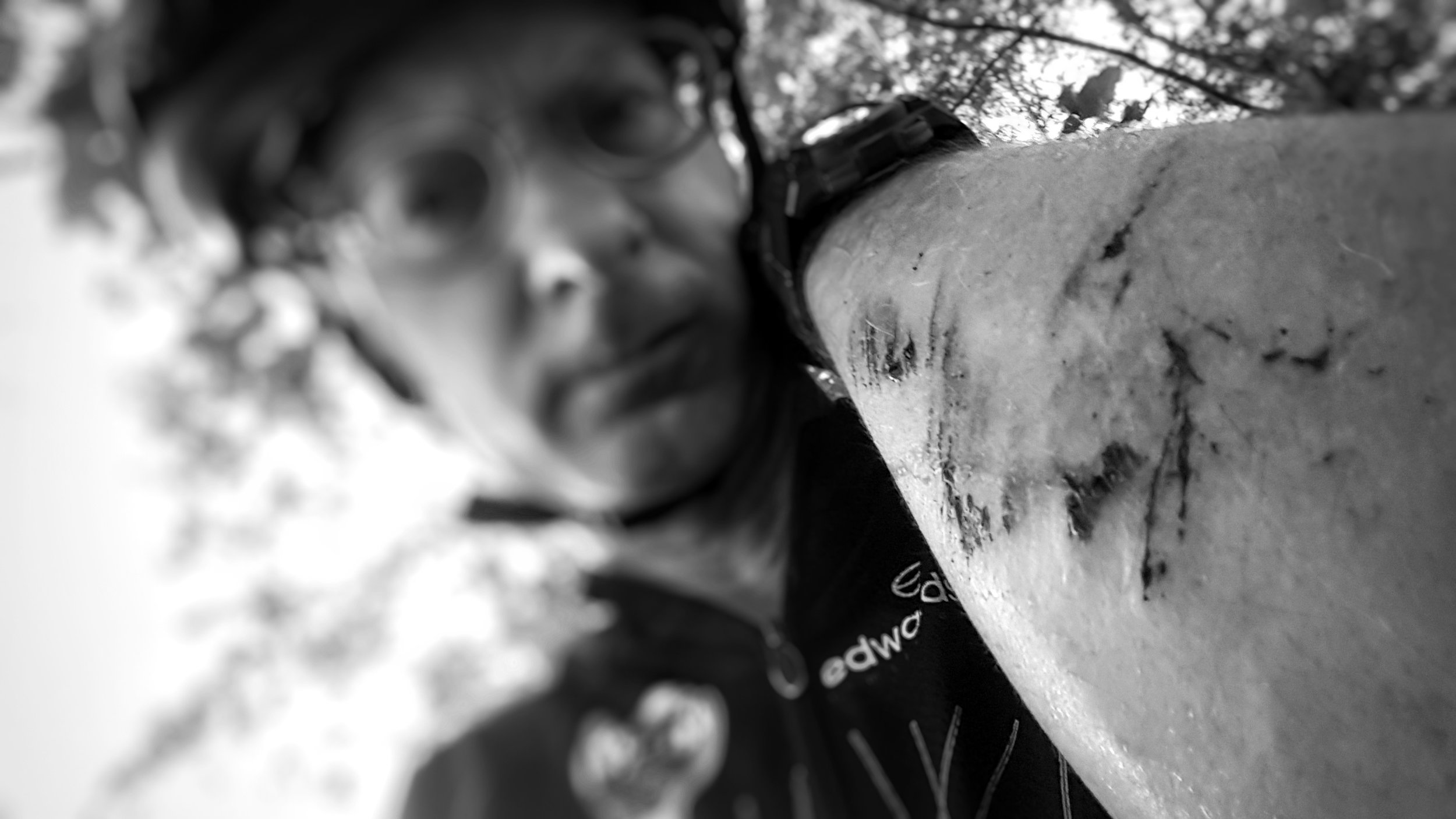March, 2011
I've never had to open up a survival blanket before. I'm doing so now in my living room - just curious if it's big enough to shelter 3 people. I carried this thing in the bottom of my backpack during a week of mountain biking in the desert, just in case.
In mid March, 2011, John A, Kathleen P and I mounted an attempt to ride the Kokopelli Trail. Kokopelli is a backcountry route from Loma CO to Moab UT over singletrack and jeep roads. While there are a number of designated camping areas along the trail, there's no food, no water and no real shelter between one end and the other. Our friend Doug stepped up to support us with the logistics of feeding and camping along the 142 mile route. He's quick-thinking, thorough, even-tempered, and is himself an experienced long-distance cyclist. He embraced this as a great adventure and put more effort into planning and preparation than John, Kat or I did.
John, Kat and I would head out on the Kokopelli in the mornings, carrying our food and water for the day, and meet Doug later in the afternoons at camping areas accessible by vehicles. Our rides would take us deep into canyons and out into the open desert. The three of us are no strangers to long days in the saddle. We have quite a bit of experience riding in the Rockies, we're Leadville vets, etc. We consider ourselves to be competent backcountry riders and our daily goals seemed quite reasonable.
The third day was to be our toughest ride. 42 miles is not a particularly long distance, but the terrain we would be covering was very challenging. (Cowskin to Castle Rock for those of you following along on a map) We’d start with a climb up a mesa, then down into and up out of two more canyons … before lunch. After lunch, we were faced with a steady 18 mile climb on a dirt road to a point called Bull Draw, on top of a mesa at 8500 ft. At Bull Draw, our dirt road was to become paved for a nice six mile descent to camp.
The day began beautifully: bright and cool, but quickly warming. The scenery was sensational as we dropped into slot canyons, riding rock trails and ledges. Sometimes we'd be up on top looking down and sometimes we'd be at the bottom looking up. While the riding was challenging, we weren't faced with anything unexpected.
We made our lunch stop in a stand of junipers in the broad Fisher Valley. On this day, there was only one possible spot to bail out of the Kokopelli Trail, and this was it. There were no other places to get assistance or supplies and no other shortcuts to civilization. It was 2:15 in the afternoon. It didn’t dawn on any of us "competent" long-distance riders that we had only covered a third of our daily distance, but had already used more than half of our daylight. Simple math would have told us that we would still be out after sunset. We were not equipped for night riding. We knew that we had 18 miles of dirt-road climbing, but 18 miles is practically child's play, right?.
We lingered a little too long over lunch and began the long climb out of Fisher Valley. The jeep road was wide and safe, but the surface was loose dirt so it was hard to maintain momentum. Kathleen was feeling a little sluggish. This isn’t a criticism of her ability. She was stronger than I was yesterday, today it is her turn to suffer. Maybe it was cumulative fatigue or maybe it was the altitude, but we were having to stop and regroup with regularity. We were making only three miles an hour.
Meanwhile, Doug had already set up our campsite for the evening. From the campsite, Doug drove up the pavement to Bull Draw at the top of the mesa, and where the road turns to dirt he looked out in the direction from which we would be coming on our bikes. As far as he could see, our route was covered in snow. There were tracks from another vehicle that had attempted the road, but they didn’t go far. Doug could see that we were heading into - on our bikes - a mountain pass that hadn’t been traversed on anything other than a snowmobile since sometime last autumn. He got back into the car, and drove the 30 or 40 miles down the mesa, out of one canyon, and up the Fisher Valley to the place where we had stopped for lunch - our pre-determined bail-out spot, because he quite reasonably assumed that we would not ride into a snow field. And there he sat as the afternoon went on, occasionally trying his cell phone, which was not receiving a signal in the valley.
On the trail, we continued climbing. Neither John nor Kathleen’s odometers were working, but everyone likes to see progress, so I would ride ahead a mile and then stop to regroup. Kathleen was struggling on this long climb. Sometimes John would ride with me and sometimes with Kat, but mostly he hung out between us - keeping Kat in sight, but letting her ride on her own. We went on like this for miles. It was getting cooler as we climbed. We, the "competent" mountain bikers, each had a light jacket in our packs, but that was about it for extra clothing.
a long afternoon about to become a long evening
While we'd been encountering intermittent patches of melting snow for a couple of miles, with about six miles to go in our climb we found our first snowbank which caused us to dismount our bikes and walk through it. It was small, and of no real consequence on its own. But somehow we, the "competent" cyclists, ignored its monumental significance ... that here was a snow bank, and we still have six miles of climbing, and it is late in the afternoon. I just wrote it off as a spot that the sun doesn't hit and thought things would get better.
Very quickly, the road became deeply muddy. The transition from dry to mud was abrupt enough that I assumed this was just an isolated spot - that we would soon find ourselves on dry dirt again.
We didn't. Honestly, for those of us who have ridden in the high country, I ask with perfect hindsight, “when has a road or trail ever - EVER - improved with altitude?” The mud was sticky gumbo that collected on our tires and drivetrains and then our wheels wouldn’t go around any more. So we started walking. Still forward. It didn’t occur to us yet that maybe we should turn around, and ride that dry road behind us back down the hill to our bail-out spot, where our crew would eventually come looking for us. I guess we were locked into the idea that the distance to the top was shorter than the distance behind, so forward we went.
We walked, slipping and sliding, pushing our bikes which had to weigh about 45lb with all the collected mud. After about an hour, we held a little council. Should we turn around? Ahead was 4 more miles of climbing - probably walking. And by this point turning around and going downhill in the mud probably also meant walking. So here we were, finally realizing a couple of hours too late that we were in too deep. It was cooling off, we were pooped, the wind was coming up, it was getting dark and we were still going up, not down. We talked of splitting up, with one of us going ahead to tell Doug what was happening but decided to stay together. I did have this survival blanket in my pack, and if it came to where we had to spend a night on out on this mesa, I’d like the body heat of a couple other folks in there with me. Also, we’d been seeing big cat pawprints - as big as my palm. I didn’t want to be alone in the wilderness after dark. We’d occasionally try a cell phone call to tell Doug that we were running late, but here in canyon country , we couldn‘t connect. Even when we had service on the high ground, Doug didn‘t down in the valleys. Kat fired off a text, thinking that Doug would receive it whenever he got back into a coverage area. John & I didn’t know what it said. We stuck together and pushed on through the mud.
At nearly the last moment with enough daylight to read the map, we fixed our position with about two and a half more miles of climbing to Bull Draw. We also had reached the snowfield.
During this time, Doug had made the 60-80 mile round trip again between our bail-out point in the valley, and Bull Draw up on top, just to see if there was any sign of us. While up on top, he'd tried to drive into the snow with the idea that if it was not too deep, he could come meet us. It was a great thought, but the road hugged the side of the mesa with no turnaround points, and even with four-wheel drive the Durango started a sideways slide that told Doug he'd gone far enough. So back down to Fisher Valley he went. Waiting in the valley, he was more than concerned. He didn’t consider the snowfield to be passable on bikes and there was no sign of us up there, yet we were not down here, either, and it was evening. He said he got out of the car and walked a way up the road, said a prayer for us, concluded that we were in trouble, and that he was not going to be able to help us on his own.
Far above, we were struggling in the snowfield. I don't want to over-dramatize our situation. We had some things going for us: we were not lost, we knew where we were, we had food in our packs, my survival blanket for shelter and someone on the outside knew we were out here ... somewhere along 42 miles of trail.
But, there was no denying that we were in a tight spot. You don't have to read many issues of Backpacker magazine to find a story very similar to ours with a grim ending. Our cause was not lost, but we had no more room to screw up. We had used our daily allotment of bad decisions. Whatever we did from here on out had to be exactly right. Moving forward was very difficult and required frequent rest, but resting meant cooling off, and that was dangerous. We had to be hyper-alert for route-finding cues, hypothermic indicators, and that precise moment when NOW is the time to stop and try to erect some kind of shelter to hunker down for the night.
We had two miles to walk, in the dark, in the snow, in our spandex cycling clothes and plastic biking shoes. Our bikes - still caked with mud - were now accumulating ice as well. We'd push them along on top of the snow, but every few steps they'd break through the crusty surface and sink to the hubs, and we'd have to heft them up again. It was totally exhausting. Carrying the bicycle was too much for Kathleen, and she simply abandoned hers - left it behind. She was stumbling a little and her teeth were chattering and I was scared for her, but it didn't seem time to stop just yet. We were simply worn out from pushing our bikes uphill through the miles of mud, and snow. I walked ahead a little bit, trying to focus on the distant point that I thought/hoped was Bull Draw. John kept encouraging both of us, and tried breaking a track for Kat to walk in. I was thinking about my wife. She was on a trip of her own in Israel. Before leaving home I promised her that I wouldn't fall off a cliff - so here I was going to freeze to death instead. It was dark now. We walked together, stopping often to rest. And in time, we tried the cell phone again.
Doug had decided to start driving out of Fisher Canyon until he had cell service, and then call for help. He had gone a few miles on the rugged dirt road when his phone chimed. He stopped, read the text from Kat. “HELP” was what it said. That probably was an accurate transmission of our emotions, but didn't give Doug much to work with. As he moved to dial 911 the phone rang in his hand. It was us.
We were able to tell Doug that we were, in fact, in the snowfield with maybe a mile and a half to go to Bull Draw and he was able to reassure us that the paved road up the other side of the mesa was open and he would meet us there. At that point, John and I also abandoned our bikes and we put our efforts into staying together and on the trail. John took the point and we walked like blind people, single file with our hands on the shoulders of the one in front. We could hear the wind roaring over our head, coming up over the top of the mesa. Taking turns leading, we’d do about thirty steps, rest, thirty steps, rest. Our feet were freezing and the icy crust bloodied our shins.
We plodded through it for what seemed an eternity, and eventually realized the snow wasn’t quite as deep as it had been. We stumbled into the wheel tracks of a truck (ours!) that had tried to drive in here, which gave us a clear path to walk in. As we finally reached the top, Bull Draw, the road became clear. Over the crest, an icy wind hit us full force, but we were on pavement, walking downhill, hugging and holding hands: obviously the first cyclists to crest Bull Draw from Fisher Valley in the 2011 season. We walked about 10 minutes more when we saw Doug’s headlights coming up toward us.
Doug is a great man of faith. I like that last sentence because you can take the word "great" and stick it in there anywhere and the statement remains true. He calls our mountaintop-to-valley cell connection a God thing, and I'm with him on that - what else could it be on a day that had offered no other communication? We got what we needed when we needed it most. Very quickly he had us in the warm truck. And before he turned it around to take us downhill, before he gave us food and water or blankets, he said, lets pray. Doug gave thanks for that phone call, for our safety and for being reunited, and we were all very, very thankful for friends we can depend to watch our backs and rescue us.
Doug lit a roaring campfire and gave us some hot food. It would take a while for us to really warm up, and as tired as I was, I didn't sleep very well that night. You can imagine that this experience left each of us with a lot to think and talk about: bad decisions, fear, exhaustion, and the various “what if” scenarios if we had had to spend the night in the snowfield. But we do these things for the experience - to try something difficult and earn a story to tell. And not even twelve hours later, at breakfast the next morning, sitting with our hands wrapped around warm mugs of campfire coffee, John kind of smiled at me and said, "It was the best!"
chris congdon




